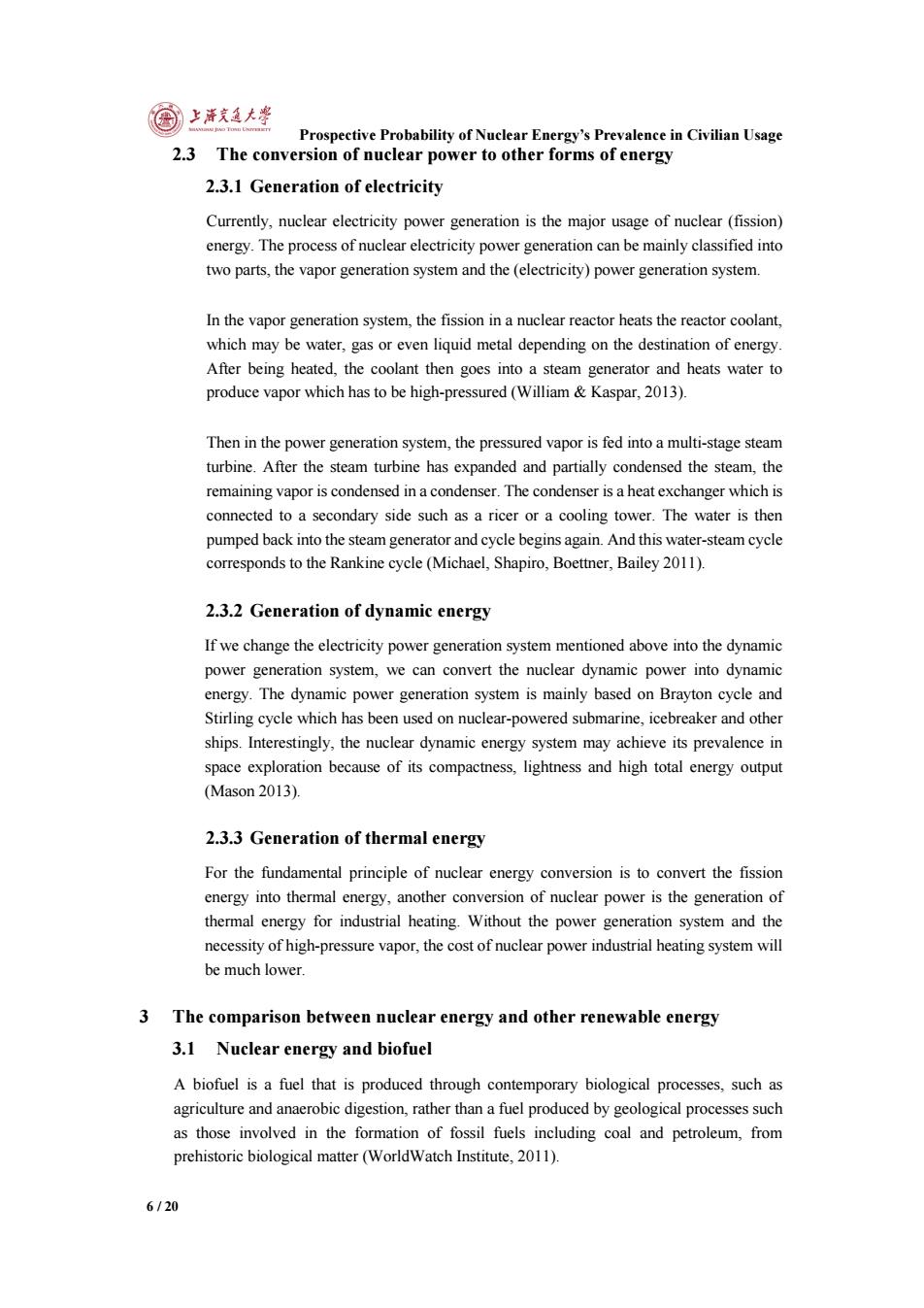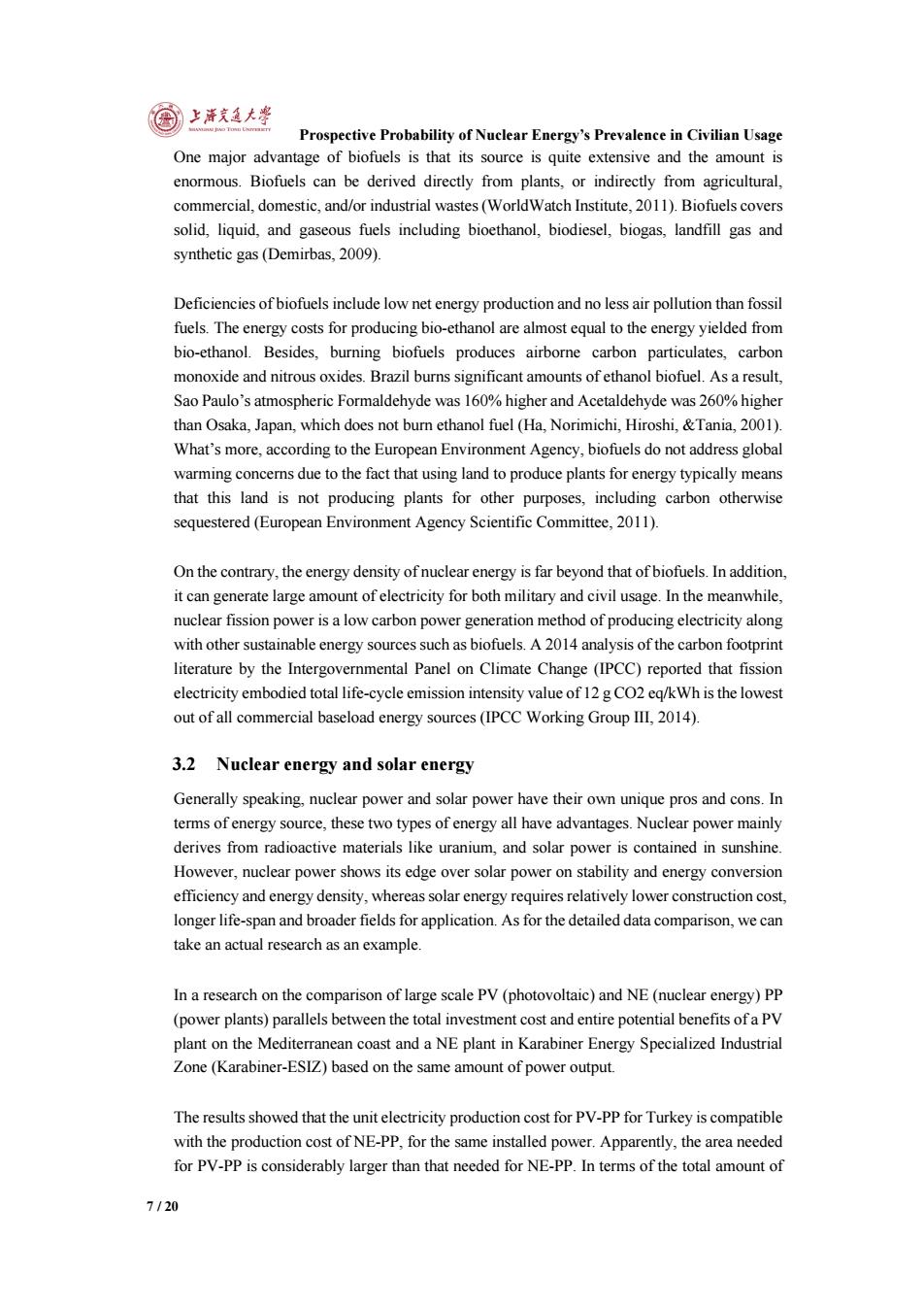
国上道大》 Prospective Probability of Nuclear Energy's Prevalence in Civilian Usage 2.3 The conversion of nuclear power to other forms of energy 2.3.1 Generation of electricity Currently,nuclear electricity power generation is the major usage of nuclear(fission) energy.The process of nuclear electricity power generation can be mainly classified into two parts,the vapor generation system and the(electricity)power generation system. In the vapor generation system,the fission in a nuclear reactor heats the reactor coolant, which may be water,gas or even liquid metal depending on the destination of energy. After being heated,the coolant then goes into a steam generator and heats water to produce vapor which has to be high-pressured (William Kaspar,2013). Then in the power generation system,the pressured vapor is fed into a multi-stage steam turbine.After the steam turbine has expanded and partially condensed the steam,the remaining vapor is condensed in a condenser.The condenser is a heat exchanger which is connected to a secondary side such as a ricer or a cooling tower.The water is then pumped back into the steam generator and cycle begins again.And this water-steam cycle corresponds to the Rankine cycle(Michael,Shapiro,Boettner,Bailey 2011). 2.3.2 Generation of dynamic energy If we change the electricity power generation system mentioned above into the dynamic power generation system,we can convert the nuclear dynamic power into dynamic energy.The dynamic power generation system is mainly based on Brayton cycle and Stirling cycle which has been used on nuclear-powered submarine,icebreaker and other ships.Interestingly,the nuclear dynamic energy system may achieve its prevalence in space exploration because of its compactness,lightness and high total energy output (Mason 2013). 2.3.3 Generation of thermal energy For the fundamental principle of nuclear energy conversion is to convert the fission energy into thermal energy,another conversion of nuclear power is the generation of thermal energy for industrial heating.Without the power generation system and the necessity of high-pressure vapor,the cost of nuclear power industrial heating system will be much lower. 3 The comparison between nuclear energy and other renewable energy 3.1 Nuclear energy and biofuel A biofuel is a fuel that is produced through contemporary biological processes,such as agriculture and anaerobic digestion,rather than a fuel produced by geological processes such as those involved in the formation of fossil fuels including coal and petroleum,from prehistoric biological matter (WorldWatch Institute.2011). 6/20
Prospective Probability of Nuclear Energy’s Prevalence in Civilian Usage 6 / 20 2.3 The conversion of nuclear power to other forms of energy 2.3.1 Generation of electricity Currently, nuclear electricity power generation is the major usage of nuclear (fission) energy. The process of nuclear electricity power generation can be mainly classified into two parts, the vapor generation system and the (electricity) power generation system. In the vapor generation system, the fission in a nuclear reactor heats the reactor coolant, which may be water, gas or even liquid metal depending on the destination of energy. After being heated, the coolant then goes into a steam generator and heats water to produce vapor which has to be high-pressured (William & Kaspar, 2013). Then in the power generation system, the pressured vapor is fed into a multi-stage steam turbine. After the steam turbine has expanded and partially condensed the steam, the remaining vapor is condensed in a condenser. The condenser is a heat exchanger which is connected to a secondary side such as a ricer or a cooling tower. The water is then pumped back into the steam generator and cycle begins again. And this water-steam cycle corresponds to the Rankine cycle (Michael, Shapiro, Boettner, Bailey 2011). 2.3.2 Generation of dynamic energy If we change the electricity power generation system mentioned above into the dynamic power generation system, we can convert the nuclear dynamic power into dynamic energy. The dynamic power generation system is mainly based on Brayton cycle and Stirling cycle which has been used on nuclear-powered submarine, icebreaker and other ships. Interestingly, the nuclear dynamic energy system may achieve its prevalence in space exploration because of its compactness, lightness and high total energy output (Mason 2013). 2.3.3 Generation of thermal energy For the fundamental principle of nuclear energy conversion is to convert the fission energy into thermal energy, another conversion of nuclear power is the generation of thermal energy for industrial heating. Without the power generation system and the necessity of high-pressure vapor, the cost of nuclear power industrial heating system will be much lower. 3 The comparison between nuclear energy and other renewable energy 3.1 Nuclear energy and biofuel A biofuel is a fuel that is produced through contemporary biological processes, such as agriculture and anaerobic digestion, rather than a fuel produced by geological processes such as those involved in the formation of fossil fuels including coal and petroleum, from prehistoric biological matter (WorldWatch Institute, 2011)

Prospective Probability of Nuclear Energy's Prevalence in Civilian Usage One major advantage of biofuels is that its source is quite extensive and the amount is enormous.Biofuels can be derived directly from plants,or indirectly from agricultural, commercial,domestic,and/or industrial wastes(WorldWatch Institute,2011).Biofuels covers solid,liquid,and gaseous fuels including bioethanol,biodiesel,biogas,landfill gas and synthetic gas(Demirbas,2009). Deficiencies of biofuels include low net energy production and no less air pollution than fossil fuels.The energy costs for producing bio-ethanol are almost equal to the energy yielded from bio-ethanol.Besides,burning biofuels produces airborne carbon particulates,carbon monoxide and nitrous oxides.Brazil burns significant amounts of ethanol biofuel.As a result. Sao Paulo's atmospheric Formaldehyde was 160%higher and Acetaldehyde was 260%higher than Osaka,Japan,which does not burn ethanol fuel (Ha,Norimichi,Hiroshi,&Tania,2001). What's more,according to the European Environment Agency,biofuels do not address global warming concerns due to the fact that using land to produce plants for energy typically means that this land is not producing plants for other purposes,including carbon otherwise sequestered(European Environment Agency Scientific Committee,2011). On the contrary,the energy density of nuclear energy is far beyond that of biofuels.In addition, it can generate large amount of electricity for both military and civil usage.In the meanwhile, nuclear fission power is a low carbon power generation method of producing electricity along with other sustainable energy sources such as biofuels.A 2014 analysis of the carbon footprint literature by the Intergovernmental Panel on Climate Change (IPCC)reported that fission electricity embodied total life-cycle emission intensity value of 12 g CO2 eq/kWh is the lowest out of all commercial baseload energy sources (IPCC Working Group III,2014). 3.2 Nuclear energy and solar energy Generally speaking,nuclear power and solar power have their own unique pros and cons.In terms of energy source,these two types of energy all have advantages.Nuclear power mainly derives from radioactive materials like uranium,and solar power is contained in sunshine. However,nuclear power shows its edge over solar power on stability and energy conversion efficiency and energy density,whereas solar energy requires relatively lower construction cost, longer life-span and broader fields for application.As for the detailed data comparison,we can take an actual research as an example. In a research on the comparison of large scale PV(photovoltaic)and NE(nuclear energy)PP (power plants)parallels between the total investment cost and entire potential benefits ofa PV plant on the Mediterranean coast and a NE plant in Karabiner Energy Specialized Industrial Zone (Karabiner-ESIZ)based on the same amount of power output. The results showed that the unit electricity production cost for PV-PP for Turkey is compatible with the production cost of NE-PP,for the same installed power.Apparently,the area needed for PV-PP is considerably larger than that needed for NE-PP.In terms of the total amount of 7/20
Prospective Probability of Nuclear Energy’s Prevalence in Civilian Usage 7 / 20 One major advantage of biofuels is that its source is quite extensive and the amount is enormous. Biofuels can be derived directly from plants, or indirectly from agricultural, commercial, domestic, and/or industrial wastes (WorldWatch Institute, 2011). Biofuels covers solid, liquid, and gaseous fuels including bioethanol, biodiesel, biogas, landfill gas and synthetic gas (Demirbas, 2009). Deficiencies of biofuels include low net energy production and no less air pollution than fossil fuels. The energy costs for producing bio-ethanol are almost equal to the energy yielded from bio-ethanol. Besides, burning biofuels produces airborne carbon particulates, carbon monoxide and nitrous oxides. Brazil burns significant amounts of ethanol biofuel. As a result, Sao Paulo’s atmospheric Formaldehyde was 160% higher and Acetaldehyde was 260% higher than Osaka, Japan, which does not burn ethanol fuel (Ha, Norimichi, Hiroshi, &Tania, 2001). What’s more, according to the European Environment Agency, biofuels do not address global warming concerns due to the fact that using land to produce plants for energy typically means that this land is not producing plants for other purposes, including carbon otherwise sequestered (European Environment Agency Scientific Committee, 2011). On the contrary, the energy density of nuclear energy is far beyond that of biofuels. In addition, it can generate large amount of electricity for both military and civil usage. In the meanwhile, nuclear fission power is a low carbon power generation method of producing electricity along with other sustainable energy sources such as biofuels. A 2014 analysis of the carbon footprint literature by the Intergovernmental Panel on Climate Change (IPCC) reported that fission electricity embodied total life-cycle emission intensity value of 12 g CO2 eq/kWh is the lowest out of all commercial baseload energy sources (IPCC Working Group III, 2014). 3.2 Nuclear energy and solar energy Generally speaking, nuclear power and solar power have their own unique pros and cons. In terms of energy source, these two types of energy all have advantages. Nuclear power mainly derives from radioactive materials like uranium, and solar power is contained in sunshine. However, nuclear power shows its edge over solar power on stability and energy conversion efficiency and energy density, whereas solar energy requires relatively lower construction cost, longer life-span and broader fields for application. As for the detailed data comparison, we can take an actual research as an example. In a research on the comparison of large scale PV (photovoltaic) and NE (nuclear energy) PP (power plants) parallels between the total investment cost and entire potential benefits of a PV plant on the Mediterranean coast and a NE plant in Karabiner Energy Specialized Industrial Zone (Karabiner-ESIZ) based on the same amount of power output. The results showed that the unit electricity production cost for PV-PP for Turkey is compatible with the production cost of NE-PP, for the same installed power. Apparently, the area needed for PV-PP is considerably larger than that needed for NE-PP. In terms of the total amount of